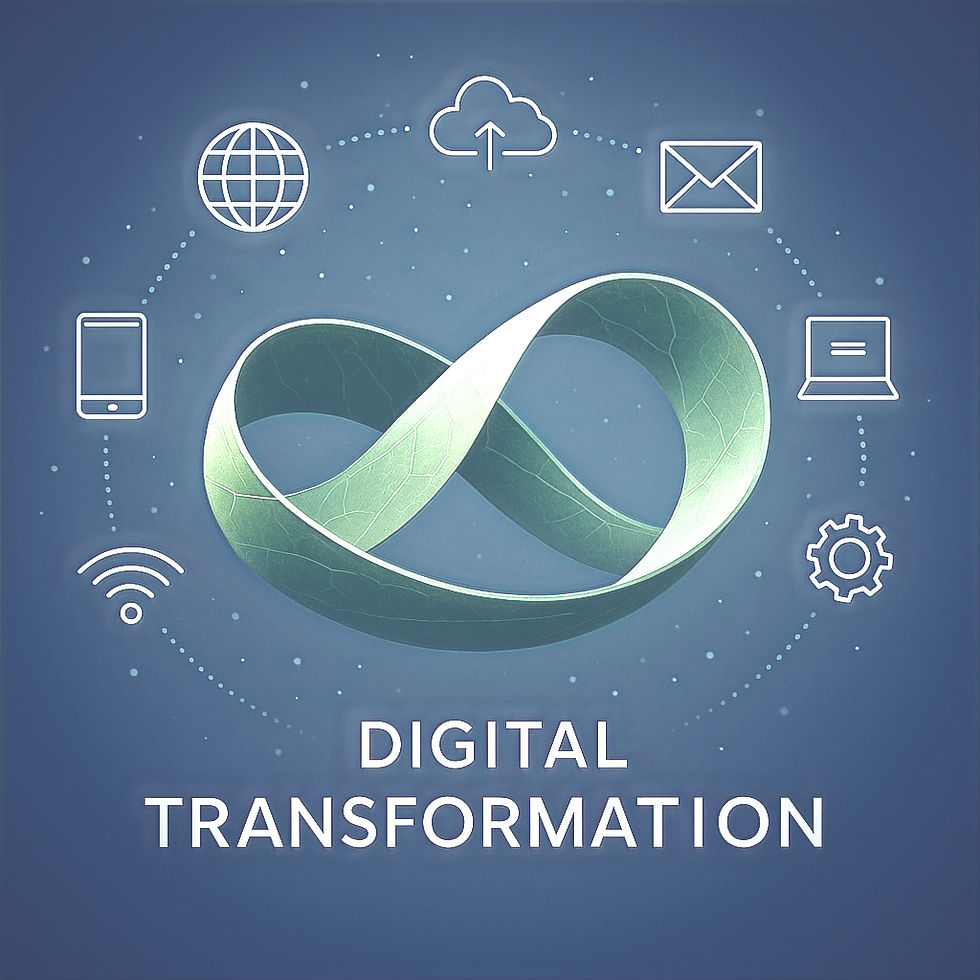Digital Transformation: More Than Just Technology
- Homy

- Aug 23, 2020
- 4 min read
Updated: Jul 24
Many digital transformation programmes fail because they focus too narrowly on technology. However, real transformation runs deeper — involving strategy, leadership, and the ability to adapt to rapidly changing customer expectations. In today’s uncertain environment, success requires more than tech. It requires a mindset shift.
Adopting a Digital Mindset: The Core of Transformation

Unlike traditional transformation programs that are slow-moving and goal-bound, digital transformation calls for a different mindset — one that embraces flexibility and continuous change. It’s not about reaching a fixed endpoint. Instead, the goal is to build an organisation that can keep evolving and adapt quickly to shifting market conditions.
One way to achieve that is by carrying out a systemic review of the four areas below:
Technology:
What new technology is there – and what use could it be to the organisation?
Technology is changing at a speed that is almost beyond belief. Cloud computing, artificial intelligence and mobile computing are becoming the norm; many of us have an ‘Alexa’ in our homes, and virtual and augmented reality will soon start radically impacting our lives. The interconnection of devices and growth of data are also creating new ways of working and serving customers that are dominating executives’ agendas as they look for ways to adopt and leverage these technologies.
People:
How are people’s interactions with companies and each other becoming more complex, and how does this affect the brand and value proposition?
It’s not just technology that is changing. People are evolving too, as technology drives rapid changes in the way that customers and employees engage with companies and each other. Changing behaviour is also taking control away from businesses. For example, a company may be the subject of countless conversations on social media, without being aware of or able to respond quickly.
Supply and demand:
What changes are there in supply and demand – and what opportunities do they bring?
Consumer demands are evolving, with customers increasingly seeking products and services that are more tailored and transparent. Technology can help organisations to respond to this, enabling them to better predict and customise their products and services. New distribution models and platforms are also disaggregating the old value chains, providing new opportunities for new entrants to offer innovative alternatives and propositions, and exerting pressure on margins.
Action:
What actions should an organisation take to respond to these changes and opportunities?
Organisations must identify what level of change they need to implement. Some may find that they do not need a digital transformation programme at all – perhaps a more straightforward initiative, such as optimising their current IT systems and leveraging new technologies like Robotic Process Automation (RPA), will bring them the results they need. Some may focus on tailoring their value proposition or introducing new products and services to remain competitive. Others will realise that they need a dramatic digital transformation if they are to stay competitive and relevant to their customers now and in the future.
Why Strategy, Leadership, and Execution Still Matter
In addition to reviewing the four areas outlined above, digital transformation necessitates a renewed focus and a shift in perspective on strategy, leadership, and execution.
Strategy
Traditional forms of strategic planning do not suit digital transformations. A scenario-based approach is necessary to help organisations focus on what they can control and what they need to respond to using a ‘test and learn’ approach. An organisation’s strategy also needs to be refreshed frequently to respond to rapid developments in technology, people, and supply and demand.
Leadership
A company could have the best technology and strategy in the world, but they would be worthless if its people were not engaged with the process, which is where effective leadership comes in. While the role of leadership has always been critical, it is even more so for digital transformation. This is due to ongoing uncertainty and the increase in complex problems (i.e., those for which cause and effect are unclear) that companies are facing. To tackle complex problems, leaders – rather than external experts – need to adopt a test-and-learn approach and encourage a culture of safe failures that enhance their organisation’s learning capabilities.
Execution
Goals for digital transformation programmes should include both specific financial targets and strategic objectives, such as developing new capabilities and fostering an enduring culture. An execution plan needs to account for both of these. While many organisations have adopted the motto of ‘fail fast and safe, and capture the learning’, an execution model must assess which problems are complex – and therefore which require a test-and-learn approach. To tackle complicated problems (i.e. those for which cause and effect are clear), using external experts remains the better solution. Finally, as the goals of transformation programmes can change, organisations need to adapt accordingly, even if that means cancelling or significantly changing the scope of some projects.
Digital transformation isn’t a finish line — it’s a new way of running. The organisations that thrive will be those that treat adaptability not as an event, but as a core capability.
Resources:
The Digital Transformation Playbook: Rethink Your Business for the Digital Age; David L. Rogers, 2017
Machine, Platform, Crowd: Harnessing the Digital Revolution; Andrew McAfee and Erik Brynjolfsson, 2017
The Big Shift in Strategy - Parts 1 & 2; John Hagel, Edge Perspectives, 2014
Immunity to Change: How to Overcome It and Unlock the Potential in Yourself and Your Organization (Leadership for the Common Good); Robert Kegan and Lisa Laskow Lahey, 2009
A leader’s framework for decision making; David J. Snowden and Mary E. Boone, HBR, November 2007






Comments